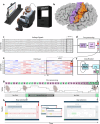A click-based electrocorticographic brain-computer interface enables long-term high-performance switch scan spelling
- PMID: 39433597
- PMCID: PMC11494178
- DOI: 10.1038/s43856-024-00635-3
A click-based electrocorticographic brain-computer interface enables long-term high-performance switch scan spelling
Abstract
Background: Brain-computer interfaces (BCIs) can restore communication for movement- and/or speech-impaired individuals by enabling neural control of computer typing applications. Single command click detectors provide a basic yet highly functional capability.
Methods: We sought to test the performance and long-term stability of click decoding using a chronically implanted high density electrocorticographic (ECoG) BCI with coverage of the sensorimotor cortex in a human clinical trial participant (ClinicalTrials.gov, NCT03567213) with amyotrophic lateral sclerosis. We trained the participant's click detector using a small amount of training data (<44 min across 4 days) collected up to 21 days prior to BCI use, and then tested it over a period of 90 days without any retraining or updating.
Results: Using a click detector to navigate a switch scanning speller interface, the study participant can maintain a median spelling rate of 10.2 characters per min. Though a transient reduction in signal power modulation can interrupt usage of a fixed model, a new click detector can achieve comparable performance despite being trained with even less data (<15 min, within 1 day).
Conclusions: These results demonstrate that a click detector can be trained with a small ECoG dataset while retaining robust performance for extended periods, providing functional text-based communication to BCI users.
Plain language summary
Amyotrophic lateral sclerosis (ALS) is a progressive disease of the nervous system that causes muscle weakness and leads to paralysis. People living with ALS therefore struggle to communicate with family and caregivers. We investigated whether the brain signals of a participant with ALS could be used to control a spelling application. Specifically, when the participant attempted a grasping movement, a computer method detected increased brain signals from electrodes implanted on the surface of his brain, and thereby generated a mouse-click. The participant clicked on letters or words from a spelling application to type sentences. Our method was trained using 44 min’ worth of brain signals and performed reliably for three months without any retraining. This approach can potentially be used to restore communication to other severely paralyzed individuals over an extended time period and after only a short training period.
© 2024. The Author(s).
Conflict of interest statement
The authors declare no competing interests.
Figures





Update of
-
A click-based electrocorticographic brain-computer interface enables long-term high-performance switch-scan spelling.Res Sq [Preprint]. 2023 Sep 25:rs.3.rs-3158792. doi: 10.21203/rs.3.rs-3158792/v1. Res Sq. 2023. Update in: Commun Med (Lond). 2024 Oct 22;4(1):207. doi: 10.1038/s43856-024-00635-3. PMID: 37841873 Free PMC article. Updated. Preprint.
References
-
- Benabid, A. L. et al. An exoskeleton controlled by an epidural wireless brain–machine interface in a tetraplegic patient: a proof-of-concept demonstration. Lancet Neurol.18, 1112–1122 (2019). - PubMed
Associated data
Grants and funding
LinkOut - more resources
Full Text Sources
Medical
Miscellaneous

